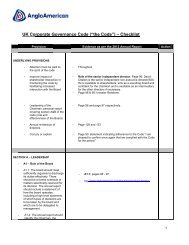Anglo American Annual Report 2012
Anglo American Annual Report 2012
Anglo American Annual Report 2012
- No tags were found...
You also want an ePaper? Increase the reach of your titles
YUMPU automatically turns print PDFs into web optimized ePapers that Google loves.
FINANCIAL STATEMENTS NOTES TO THE FINANCIAL STATEMENTS1. ACCOUNTING POLICIES continuedInventoryInventory and work in progress are measured at the lower of cost and netrealisable value. The production cost of inventory includes an appropriateproportion of depreciation and production overheads. Cost is determinedon the following bases:• Raw materials and consumables are measured at cost on a first in, first out(FIFO) basis or a weighted average cost basis.• Finished products are measured at raw material cost, labour cost anda proportion of manufacturing overhead expenses.• Metal and coal stocks are included within finished products and aremeasured at average cost.At precious metals operations that produce ‘joint products’, cost is allocatedamongst products according to the ratio of contribution of these metals togross sales revenues.Retirement benefitsThe Group operates both defined benefit and defined contribution pensionplans for its employees as well as post employment medical plans. Fordefined contribution plans the amount recognised in the income statement isthe contributions paid or payable during the year.For defined benefit pension and post employment medical plans, full actuarialvaluations are carried out every three years using the projected unit creditmethod and updates are performed for each financial year end. The averagediscount rate for the plans’ liabilities is based on AA rated corporate bonds ofa suitable duration and currency or, where there is no deep market for suchbonds, is based on government bonds. Pension plan assets are measuredusing year end market values.Actuarial gains and losses, which can arise from differences between expectedand actual outcomes or changes in actuarial assumptions, are recognisedimmediately in the statement of comprehensive income. Any increase in thepresent value of plan liabilities expected to arise from employee serviceduring the year is charged to operating profit. The expected return on planassets and the expected increase during the year in the present value of planliabilities are included in investment income and interest expense respectively.Past service cost is recognised immediately to the extent that the benefits arealready vested and otherwise is amortised on a straight line basis over theaverage period until the benefits vest.The retirement benefit obligation recognised in the balance sheet representsthe present value of the defined benefit obligation as adjusted for unrecognisedpast service costs and as reduced by the fair value of plan assets. Any assetresulting from this calculation is limited to past service cost, plus the presentvalue of available refunds and reductions in future contributions to the plan.TaxThe tax expense includes the current tax and deferred tax charge recognisedin the income statement.Current tax payable is based on taxable profit for the year. Taxable profitdiffers from net profit as reported in the income statement because itexcludes items of income or expense that are taxable or deductible in otheryears and it further excludes items that are not taxable or deductible. TheGroup’s liability for current tax is calculated using tax rates that have beenenacted or substantively enacted by the reporting date.Deferred tax is recognised in respect of temporary differences between thecarrying amounts of assets and liabilities for financial reporting purposes andthe amounts used for taxation purposes. Deferred tax liabilities are generallyrecognised for all taxable temporary differences and deferred tax assets arerecognised to the extent that it is probable that taxable profits will be availableagainst which deductible temporary differences can be utilised. Such assetsand liabilities are not recognised if the temporary differences arise from theinitial recognition of goodwill or of an asset or liability in a transaction (otherthan in a business combination) that affects neither taxable profit noraccounting profit.Deferred tax liabilities are recognised for taxable temporary differencesarising on investments in subsidiaries, joint ventures and associates exceptwhere the Group is able to control the reversal of the temporary differenceand it is probable that the temporary difference will not reverse in theforeseeable future.The carrying amount of deferred tax assets is reviewed at each reporting dateand is adjusted to the extent that it is no longer probable that sufficient taxableprofit will be available to allow all or part of the asset to be recovered.Deferred tax is calculated at the tax rates that are expected to apply in theperiod when the liability is settled or the asset is realised, based on the lawsthat have been enacted or substantively enacted by the reporting date.Deferred tax is charged or credited to the income statement, except whenit relates to items charged or credited directly to equity, in which case thedeferred tax is also taken directly to equity.Deferred tax assets and liabilities are offset when they relate to income taxeslevied by the same taxation authority and the Group intends to settle itscurrent tax assets and liabilities on a net basis in that taxation authority.LeasesIn addition to lease contracts, other significant contracts are assessed todetermine whether, in substance, they are or contain a lease. This includesassessment of whether the arrangement is dependent on use of a specificasset and the right to use that asset is conveyed through the contract.Rental costs under operating leases are recognised in the income statementin equal annual amounts over the lease term. Finance lease assets arerecognised as assets of the Group on inception of the lease at the lower of fairvalue or the present value of the minimum lease payments discounted at theinterest rate implicit in the lease.Non-current assets and disposal groups held for saleNon-current assets and disposal groups are classified as held for sale if theircarrying amount will be recovered through a sale transaction rather thanthrough continuing use. This condition is regarded as met only when a sale ishighly probable within one year from the date of classification, managementis committed to the sale and the asset or disposal group is available forimmediate sale in its present condition.Non-current assets and disposal groups are classified as held for sale fromthe date these conditions are met and are measured at the lower of carryingamount and fair value (less costs to sell). Any resulting impairment loss isrecognised in the income statement as a special item. On classification asheld for sale the assets are no longer depreciated. Comparative amountsare not adjusted.Environmental restoration and decommissioning obligationsAn obligation to incur environmental restoration, rehabilitation anddecommissioning costs arises when disturbance is caused by thedevelopment or ongoing production of a mining property. Such costsarising from the decommissioning of plant and other site preparation work,discounted to their net present value, are provided for and capitalised at thestart of each project, as soon as the obligation to incur such costs arises.These costs are recognised in the income statement over the life of theoperation, through the depreciation of the asset and the unwinding of thediscount on the provision. Costs for restoration of subsequent site damagewhich is created on an ongoing basis during production are provided forat their net present values and recognised in the income statement asextraction progresses.Changes in the measurement of a liability relating to the decommissioning ofplant or other site preparation work (that result from changes in the estimatedtiming or amount of the cash flow or a change in the discount rate), are addedto or deducted from the cost of the related asset in the current period. If adecrease in the liability exceeds the carrying amount of the asset, the excessis recognised immediately in the income statement. If the asset value isincreased and there is an indication that the revised carrying value is notrecoverable, an impairment test is performed in accordance with theaccounting policy set out above.For some South African operations annual contributions are made todedicated environmental rehabilitation trusts to fund the estimated cost ofrehabilitation during and at the end of the life of the relevant mine. The Groupexercises full control of these trusts and therefore the trusts are consolidated.The trusts’ assets are disclosed separately on the balance sheet as noncurrentassets. The trusts’ assets are measured based on the nature of theunderlying assets in accordance with accounting policies for similar assets.144 <strong>Anglo</strong> <strong>American</strong> plc <strong>Annual</strong> <strong>Report</strong> <strong>2012</strong>



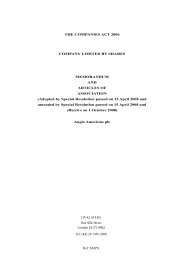
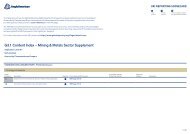
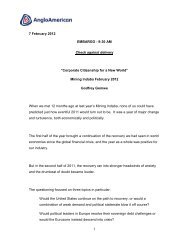
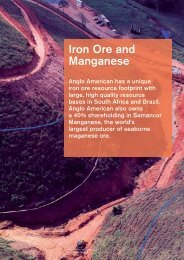

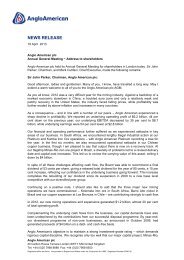
![English PDF [ 189KB ] - Anglo American](https://img.yumpu.com/50470814/1/184x260/english-pdf-189kb-anglo-american.jpg?quality=85)
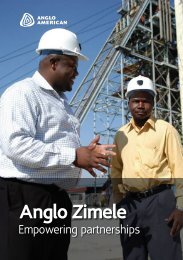


![pdf [ 595KB ] - Anglo American](https://img.yumpu.com/49420483/1/184x260/pdf-595kb-anglo-american.jpg?quality=85)
![pdf [ 1.1MB ] - Anglo American](https://img.yumpu.com/49057963/1/190x240/pdf-11mb-anglo-american.jpg?quality=85)
